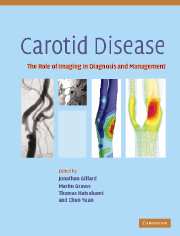Book contents
- Frontmatter
- Contents
- List of contributors
- List of abbreviations
- Introduction
- Background
- 1 Pathology of carotid artery atherosclerotic disease
- 2 Epidemiology of carotid artery atherosclerosis
- 3 Genetics of carotid atherosclerosis
- 4 Hematological processes in emboli formation
- 5 Medical treatment for carotid stenosis
- 6 Surgical management of symptomatic carotid disease: carotid endarterectomy and extracranial-intracranial bypass
- 7 Surgery for asymptomatic carotid stenosis
- 8 Interventional management of carotid disease
- Luminal imaging techniques
- Morphological plaque imaging
- Functional plaque imaging
- Plaque modelling
- Monitoring the local and distal effects of carotid interventions
- Monitoring pharmaceutical interventions
- Future directions in carotid plaque imaging
- Index
- References
2 - Epidemiology of carotid artery atherosclerosis
from Background
Published online by Cambridge University Press: 03 December 2009
- Frontmatter
- Contents
- List of contributors
- List of abbreviations
- Introduction
- Background
- 1 Pathology of carotid artery atherosclerotic disease
- 2 Epidemiology of carotid artery atherosclerosis
- 3 Genetics of carotid atherosclerosis
- 4 Hematological processes in emboli formation
- 5 Medical treatment for carotid stenosis
- 6 Surgical management of symptomatic carotid disease: carotid endarterectomy and extracranial-intracranial bypass
- 7 Surgery for asymptomatic carotid stenosis
- 8 Interventional management of carotid disease
- Luminal imaging techniques
- Morphological plaque imaging
- Functional plaque imaging
- Plaque modelling
- Monitoring the local and distal effects of carotid interventions
- Monitoring pharmaceutical interventions
- Future directions in carotid plaque imaging
- Index
- References
Summary
Introduction
Cardiovascular disease, including stroke and myocardial infarction, is the leading cause of death and disability in the Western world (Thom et al., 2006). When considered separately from other cardiovascular diseases, stroke is a leading cause of mortality, ranked third behind diseases of the heart and cancer (Thom et al., 2006). There are estimated to be 500 000 newly diagnosed cases of stroke in the USA annually, the majority of which are ischemic in nature (Thom et al., 2006). The age-adjusted incidence rate of stroke is substantially greater in Blacks than Whites (White et al., 2005).
Atherosclerotic cardiovascular disease in general, and ischemic stroke in particular, is usually preceded by the presence of subclinical atherosclerosis that develops in the carotid arteries and other vessels. The pathological characteristics of carotid artery atherosclerosis are described in elegant detail by Virmani et al. in Chapter 1. Here, we review the epidemiology of carotid artery atherosclerosis, including its distribution, determinants and risks conferred by its presence. The available evidence demonstrates that carotid artery atherosclerosis is common and high risk, and the identification and treatment of carotid artery atherosclerosis may substantially reduce the burden of cardiovascular disease.
Subclinical atherosclerosis precedes clinically apparent disease
From the current pathological evidence, subclinical atherosclerosis appears to be common and to precede most cases of clinically apparent disease. Atherosclerotic lesions of the human aorta, both fatty streaks and fibrous plaques, are commonly noted in autopsy studies of combatant soldiers and other teenage and young adult victims of premature noncoronary death (Solberg and Strong, 1983; Strong, 1995).
Keywords
- Type
- Chapter
- Information
- Carotid DiseaseThe Role of Imaging in Diagnosis and Management, pp. 22 - 34Publisher: Cambridge University PressPrint publication year: 2006

